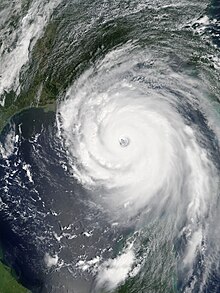Political effects of Hurricane Katrina
Hurricane Katrina struck the United States on August 29, 2005, causing over a thousand deaths and extreme property damage, particularly in New Orleans.
On September 15, 2005, it was announced that a Bipartisan Congressional Committee had been established to investigate the United States government's preparations for and responses to Hurricane Katrina.
The following information is regarding the House of Representatives' debate and more specifically, Honorable Dreier's viewpoint on whether to establish a Bipartisan Congressional Committee to investigate the U.S. government's preparations for Hurricane Katrina.
[2] Honorable Dreier agreed with President Bush when he claimed that there were many undesirable characteristics of the government's initial response to Hurricane Katrina.
In his debate to the House of Representatives, Honorable Dreier expressed that the Federal Emergency Management System's (FEMA) department head had resigned after the events of Hurricane Katrina.
He called for action from his fellow representatives that there must be an acceptance of the Executive Branch's powers to investigate what went wrong in the response to Hurricane Katrina.
In his strong declaration to the House of Representatives, Honorable Dreier made it very clear that a Bipartisan Congressional Committee was necessary in order to follow the nation's precedents and traditions.
As the ranking minority member of the Homeland Security Committee, he submitted a document outlining the complexity of the problems regarding what happened during Hurricane Katrina and the need for an independent assessment.
This will entail providing a coordinated, comprehensive federal response to any large-scale crisis and mounting a swift and effective recovery effort".
The statement authorized the Department of Homeland Security (DHS) and the Federal Emergency Management Agency (FEMA) to coordinate disaster relief and "... required emergency measures, authorized under Title V of the Stafford Act, to save lives, protect property and public health and safety, or to lessen or avert the threat of a catastrophe in the parishes of Allen, Avoyelles, Beauregard, Bienville, Bossier, Caddo, Caldwell, Claiborne, Catahoula, Concordia, De Soto, East Baton Rouge, East Carroll, East Feliciana, Evangeline, Franklin, Grant, Jackson, LaSalle, Lincoln, Livingston, Madison, Morehouse, Natchitoches, Pointe Coupee, Ouachita, Rapides, Red River, Richland, Sabine, St. Helena, St. Landry, Tensas, Union, Vernon, Webster, West Carroll, West Feliciana, and Winn."
[17] During non-emergency times, drivers of school buses must own and maintain a class D commercial license or better depending on the exact size and weight of the bus.
In spite of risks and his lack of formal training or license, 20-year-old Jabbar Gibson commandeered a New Orleans school bus and rescued 70 people from the rising floodwaters before making the 13-hour drive to Houston's Reliant Astrodome, arriving on Wednesday evening.
[23][24] Early questions arose on why the flood protection system designed and built by the US Army Corps of Engineers failed catastrophically in 53 different places in metro New Orleans.
This decision was made by the Corps decades ago "based on a cost-benefit analysis", according to Lt. Gen. Carl Strock, USACE's Chief of Engineers.
[29] According to scientist Robert Twilley, the effects of the storm surge that overcame New Orleans and the surrounding parishes would have been drastically reduced had wetlands been present.
[30] In the days following the evacuation of New Orleans, Reuters reported that "[i]nterviews with refugees in Houston, which is expecting many thousands of evacuees to remain, suggest that thousands of black people who lost everything and had no insurance will end up living in Texas or other U.S. states," and Forbes magazine notes that "those left homeless will take part in the biggest internal migration of people since the days of the Dust Bowl and the Great Depression.
FEMA, which was elevated to cabinet-level status under Bill Clinton and later incorporated into the Department of Homeland Security, which placed high priority on counter-terrorism and disaster preparation.
Some members of the International Association of Emergency Managers had predicted that FEMA could not adequately respond to a catastrophe due to the integration and staffing overlaps.
Prior to joining FEMA, Brown had no experience in disaster relief and had even been fired from his previous job as a supervisor of judging at the International Arabian Horse Association.
After closer scrutiny prompted by FEMA's coordination efforts with local officials before Hurricane Katrina, it was found that Brown had "mis-represented" several of his credentials which lower staffers had not discovered when vetting him for presidential appointment to his position.
[38] Kellogg Brown & Root, a former subsidiary of Halliburton, is doing major repairs at Navy facilities along the Gulf Coast that were damaged by the hurricane.
Other no-bid contracts were awarded to the Fluor Corporation, a disaster recovery specialist company based in southern California, and The Shaw Group of Baton Rouge, La.
[39] The Shaw Group disclosed, in its annual report filed on July 5, that it is the subject of what the company describes as an "informal inquiry" by the Securities and Exchange Commission, and as policy regarding any investigation, the SEC declined to comment.
Federal securities class-action cases accused the Shaw Group and its executives of defrauding investors with misleading statements concerning the company's finances and management.

